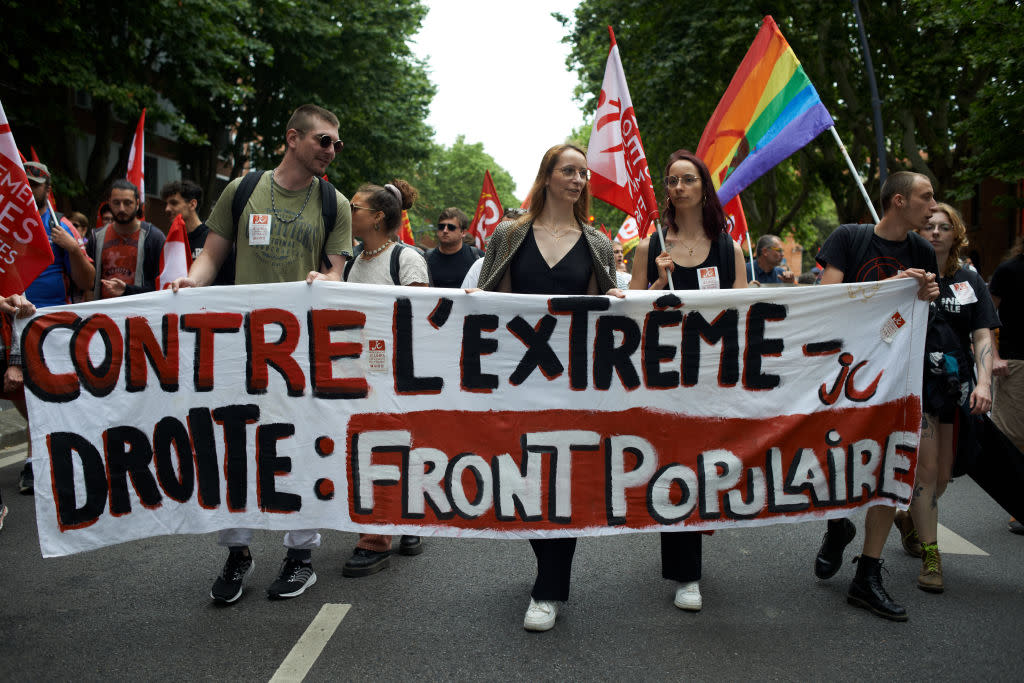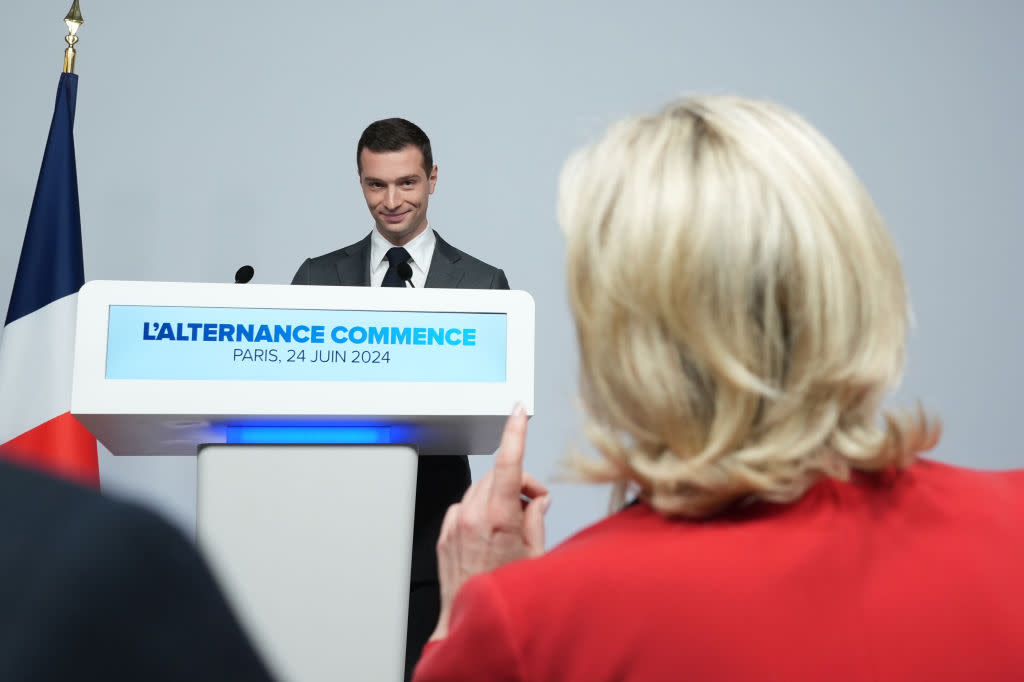What a New Left-Wing Alliance Means for France

Protesters hold a banner that reads "Against the far-right: Popular Front" in Toulouse, France, on June 15, 2024. Credit - Alain Pitton—NurPhoto/Getty Images
When French voters delivered Marine Le Pen’s far-right National Rally party an overwhelming victory in this month’s European Parliament elections, President Emmanuel Macron took a risky and unexpected gamble. He called a snap election, set to begin this Sunday, in which the French people would be given a choice: replicate the decision made in the European elections and hand the far right the keys to national governance, or help thwart them by backing his centrist Renaissance party, which since 2022 has served in a minority government, instead.
But Macron failed to anticipate that voters would have a third option. Just days after the contest was announced, the country’s main left-wing parties—among them the center-left Socialists, the Greens, the Communists, and Jean-Luc Mélenchon’s hard-left France Unbowed—announced a new electoral pact. Dubbed the “New Popular Front”—which borrows its name from a short-lived political coalition between Socialists and Communists that emerged in response to the threat of fascism in the 1930s—the four-party alliance has committed to campaign on a common platform with a joint list of candidates. “The arrival of the National Rally in power is no longer inevitable,” the parties said in a joint statement, adding: “Hope is here!”
While Macron’s apparent inability to foresee the formation of this left-wing alliance could prove calamitous for his party’s prospects, it wasn’t without reason. Until recently, the French left was widely regarded as a spent force, fractured between an array of parties with vehement disagreements over issues such as support for Ukraine, the ongoing war in Gaza, and their attitudes toward the E.U. Previous attempts at uniting—most recently for the 2022 parliamentary elections—have largely floundered.
“It’s a ragtag coalition,” Mujtaba Rahman, the managing director for Europe at the Eurasia Group, says of the alliance, whose platform includes a pledge to reverse the unpopular pension reforms pushed through by Macron last year, as well as returning the French retirement age to 60 (down from 64). But there's strength in numbers. By forming this alliance, the left-wing parties are ensuring that the left-wing share of the votes—which, in total, has been more or less the same in each election since 2017—is no longer divided between different parties. “They're being very opportunistic,” Rahman says. “It's very tactical.”
But whether this coalition will be able to overcome its divisions long enough to survive until July 7, let alone to see these pledges through in government, is anyone’s guess. “As they come into contact with reality, it’s entirely conceivable they will disintegrate because they’re incredibly incoherent,” Rahman adds. “But for now, the creation of this bloc has created an alternative for moderate, centrist, left-leaning voters who otherwise would have felt compelled to support Macron to put a brake on Le Pen.”
Read More: How Europe’s Far-Right Parties Are Winning Over Young Voters
Individually, these left-wing parties had little to show for the European elections. But together, they are projected to secure as much as 29.5% of the national vote, according to a recent poll, putting them six points behind Le Pen’s National Rally but, crucially, 10 points ahead of Macron’s centrist alliance, which is currently polling at just 19.5%. This bodes poorly for Macron’s candidates, who will need to be among the top two candidates in the first round of voting on June 30 in order to advance to the decisive runoff on July 7.
“In many constituencies, it’s quite likely that Macronist candidates will not be selected to go to the second round,” says Mathieu Gallard, the research director at the French polling firm Ipsos. He notes, however, that a third-place candidate could scrape through if they are able to secure the support of at least 12.5% of the constituency’s registered voters. “The higher the turnout will be in the first round,” he adds, “the higher the number of three-way contests the second round will have.”
Turnout in legislative elections historically hasn’t been great. During the last one, in 2022, just 47.5% of the French electorate cast a vote for the National Assembly, compared to the 73.6% that did so during the presidential election. Still, Gallard says there’s an expectation that turnout will be higher than previous National Assembly votes, which have historically been eclipsed by the presidential contests preceding them. (Macron, whose term ends in 2027, will not be on the ballot.)
Should Macron’s candidates be squeezed out of the second round, his centrist backers could become the deciding factor—that is, if they choose to vote at all. In such a scenario, “I don’t expect very much that … the Macronist candidate will massively back the left,” Gallard says. “I expect them to divide their vote more or less in half between the two candidates, with many abstaining.”

The stakes of this election—which will decide the next prime minister and, consequently, who will determine domestic policy going forward—couldn’t be higher for everyone involved. “National Rally voters think that for the first time, they have a chance to win power,” Gallard says. “Left-wing voters are very afraid of this possibility and they also think that maybe they can win power. And Macronist voters are very afraid of both possibilities.”
While Macron's centrist alliance has sought to convince voters that its far-right and left-wing rivals are not to be trusted on key issues such as the economy, recent polls suggest that this argument isn't cutting through. Indeed, a recent Ipsos poll showed that more voters trust Le Pen's party on the economy (25%) than the left-wing alliance (22%) or Macron's centrist alliance (20%)—despite its lack of governing experience or warnings that a far-right government could usher in a Liz Truss-style economic meltdown of the kind seen when the short-lived British prime minister introduced billions of pounds in unfunded tax cuts before ultimately resigning in disgrace.
While Macron has called for rival parties on both sides of the political spectrum to join his own electoral alliance to defeat Le Pen, the prospects of anyone heeding that call is unlikely. Macron, who was already deeply unpopular before the election was called, “has annoyed everyone by calling the snap election,” Rahman says. “I find it hard to believe that the left or the right will want to do Macron a favor and enable him to govern.”
Should this election end in defeat for Renaissance, and in victory for either the New Popular Front or the National Rally, Macron will be forced to serve the remainder of his presidential term in a power-sharing arrangement—an outcome that would almost certainly relegate him to the status of canard boiteux, or lame duck.
As some observers see it, he may already be one. Having secured just 15% of the vote in the European elections, Macron wouldn’t have conceivably been able to continue governing without extreme resistance from rival parties—a reality that would invariably come to bear when the government attempts to pass its next budget in the fall. Should the left or the right emerge victorious after July 7, the next Assembly could be “even more dysfunctional, even more fragmented, even more paralyzed, and even less capable of doing anything than the last,” Rahman predicts. “I think there’s a risk that he is even more of a lame duck than he already was.”
Write to Yasmeen Serhan at yasmeen.serhan@time.com.






